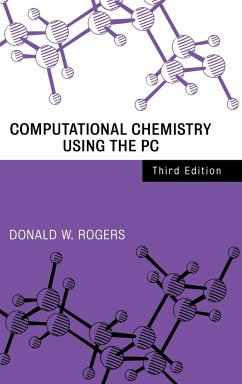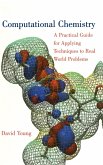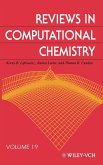Donald W. Rogers
Computational Chemistry Using the PC
Donald W. Rogers
Computational Chemistry Using the PC
- Gebundenes Buch
- Merkliste
- Auf die Merkliste
- Bewerten Bewerten
- Teilen
- Produkt teilen
- Produkterinnerung
- Produkterinnerung
Dieses Buch bietet eine Einführung in die Computeranwendungen in der Chemie, Molekülorbital- und molekülmechanischen Berechnungen. Spezifische Probleme in der Molekülmechanik, semi-empirische, ab initio und MO- Berechnungen werden aufgezeigt. Durch die rasante Entwicklung innerhalb der letzten drei Jahre bei Hard- und Software war eine weitere Auflage unumgänglich geworden. Anspruchsvolles Hintergrundwissen wird weder in Mathematik noch in der Computerprogrammierung vorausgesetzt. Im Bedarfsfall werden mathematische Grundstrukturen stufenweise aufgebaut. Dem Buch ist eine Diskette mit ca. 50…mehr
Andere Kunden interessierten sich auch für
![Computational Chemistry Computational Chemistry]() David YoungComputational Chemistry178,99 €
David YoungComputational Chemistry178,99 €![Reviews in Computational Chemistry, Volume 4 Reviews in Computational Chemistry, Volume 4]() Kenny B. Lipkowitz / Donald B. Boyd (Hgg.)Reviews in Computational Chemistry, Volume 4332,99 €
Kenny B. Lipkowitz / Donald B. Boyd (Hgg.)Reviews in Computational Chemistry, Volume 4332,99 €![Reviews in Computational Chemistry, Volume 25 Reviews in Computational Chemistry, Volume 25]() Kenny B. LipkowitzReviews in Computational Chemistry, Volume 25261,99 €
Kenny B. LipkowitzReviews in Computational Chemistry, Volume 25261,99 €![Reviews in Computational Chemistry, Volume 7 Reviews in Computational Chemistry, Volume 7]() Kenny B. Lipkowitz / Donald B. Boyd (Hgg.)Reviews in Computational Chemistry, Volume 7332,99 €
Kenny B. Lipkowitz / Donald B. Boyd (Hgg.)Reviews in Computational Chemistry, Volume 7332,99 €![Reviews in Computational Chemistry, Volume 5 Reviews in Computational Chemistry, Volume 5]() Kenny B. Lipkowitz / Donald B. Boyd (Hgg.)Reviews in Computational Chemistry, Volume 5332,99 €
Kenny B. Lipkowitz / Donald B. Boyd (Hgg.)Reviews in Computational Chemistry, Volume 5332,99 €![Reviews in Computational Chemistry, Volume 19 Reviews in Computational Chemistry, Volume 19]() Kenny B. Lipkowitz / Raima Larter / Thomas R. Cundari / Donald B. Boyd (Hgg.)Reviews in Computational Chemistry, Volume 19332,99 €
Kenny B. Lipkowitz / Raima Larter / Thomas R. Cundari / Donald B. Boyd (Hgg.)Reviews in Computational Chemistry, Volume 19332,99 €![Reviews in Computational Chemistry, Volume 14 Reviews in Computational Chemistry, Volume 14]() Kenny B. Lipkowitz / Donald B. Boyd (Hgg.)Reviews in Computational Chemistry, Volume 14332,99 €
Kenny B. Lipkowitz / Donald B. Boyd (Hgg.)Reviews in Computational Chemistry, Volume 14332,99 €-
-
-
Dieses Buch bietet eine Einführung in die Computeranwendungen in der Chemie, Molekülorbital- und molekülmechanischen Berechnungen. Spezifische Probleme in der Molekülmechanik, semi-empirische, ab initio und MO- Berechnungen werden aufgezeigt. Durch die rasante Entwicklung innerhalb der letzten drei Jahre bei Hard- und Software war eine weitere Auflage unumgänglich geworden. Anspruchsvolles Hintergrundwissen wird weder in Mathematik noch in der Computerprogrammierung vorausgesetzt. Im Bedarfsfall werden mathematische Grundstrukturen stufenweise aufgebaut. Dem Buch ist eine Diskette mit ca. 50 kompletten Aufgabenstellungen und ausgesuchten Dateien für das Selbststudium beigefügt.
Produktdetails
- Produktdetails
- Verlag: Wiley & Sons
- 3. Aufl.
- Seitenzahl: 349
- Erscheinungstermin: 3. Oktober 2003
- Englisch
- Abmessung: 235mm x 157mm x 24mm
- Gewicht: 574g
- ISBN-13: 9780471428008
- ISBN-10: 0471428000
- Artikelnr.: 09382217
- Herstellerkennzeichnung
- Libri GmbH
- Europaallee 1
- 36244 Bad Hersfeld
- gpsr@libri.de
- Verlag: Wiley & Sons
- 3. Aufl.
- Seitenzahl: 349
- Erscheinungstermin: 3. Oktober 2003
- Englisch
- Abmessung: 235mm x 157mm x 24mm
- Gewicht: 574g
- ISBN-13: 9780471428008
- ISBN-10: 0471428000
- Artikelnr.: 09382217
- Herstellerkennzeichnung
- Libri GmbH
- Europaallee 1
- 36244 Bad Hersfeld
- gpsr@libri.de
DONALD W. ROGERS, PhD, is Professor Emeritus at Long Island University. For forty years, Professor Rogers has taught academic courses in physical chemistry, thermodynamics, general chemistry, computational chemistry, and microcomputer interfacing. He publishes regularly in the Journal of Physical Chemistry and elsewhere, and his work has been supported for the last decade by the National Science Foundation through the National Center for Supercomputing Applications.
Preface to the Third Edition.
Preface to the Second Edition.
Preface to the First Edition.
Chapter 1. Iterative Methods.
Iterative Methods.
An Iterative Algorithm.
Blackbody Radiation.
Radiation Density.
Wien's Law.
The Planck Radiation Law.
COMPUTER PROJECT 1-1: Wien's Law.
COMPUTER PROJECT 1-2: Roots of the Secular Determinant.
The Newton-Raphson Method.
Problems.
Numerical Integration.
Simpson's Rule.
Efficiency and Machine Considerations.
Elements of Single-Variable Statistics.
The Gaussian Distribution.
COMPUTER PROJECT 1-3: Medical Statistics.
Molecular Speeds.
COMPUTER PROJECT 1-4: Maxwell-Boltzmann Distribution Laws.
COMPUTER PROJECT 1-5: Elementary Quantum Mechanics.
COMPUTER PROJECT 1-6: Numerical Integration of Experimental Data Sets.
Problems.
Chapter 2. Applications of Matrix Algebra.
Matrix Addition.
Matrix Multiplication.
Division of Matrices.
Powers and Roots of Matrices.
Matrix Polynomials.
The Least Equation.
Importance of Rank.
Importance of the Least Equation.
Special Matrices.
The Transformation Matrix.
Complex Matrices.
What's Going On Here?
Problems.
Linear Nonhomogeneous Simultaneous Equations.
Algorithms.
Matrix Inversion and Diagonalization.
COMPUTER PROJECT 2-1: Simultaneous Spectrophotometric Analysis.
COMPUTER PROJECT 2-2 j Gauss-Seidel Iteration: Mass Spectroscopy.
COMPUTER PROJECT 2-3 j Bond Enthalpies of Hydrocarbons.
Problems.
Chapter 3. Curve Fitting.
Information Loss.
The Method of Least Squares.
Least Squares Minimization.
Linear Functions Passing Through the Origin.
Linear Functions Not Passing Through the Origin.
Quadratic Functions.
Polynomials of Higher Degree.
Statistical Criteria for Curve Fitting.
Reliability of Fitted Parameters.
COMPUTER PROJECT 3-1: Linear Curve Fitting: KF Solvation.
COMPUTER PROJECT 3-2: The Boltzmann Constant.
COMPUTER PROJECT 3-3: The Ionization Energy of Hydrogen.
Reliability of Fitted Polynomial Parameters.
COMPUTER PROJECT 3-4 j The Partial Molal Volume of ZnCl2.
Problems.
Multivariate Least Squares Analysis.
Error Analysis.
COMPUTER PROJECT 3-5: Calibration Surfaces Not Passing Through the Origin.
COMPUTER PROJECT 3-6: Bond Energies of Hydrocarbons.
COMPUTER PROJECT 3-7: Expanding the Basis Set.
Problems.
Chapter 4. Molecular Mechanics: Basic Theory.
The Harmonic Oscillator.
The Two-Mass Problem.
Polyatomic Molecules.
Molecular Mechanics.
Ethylene: A Trial Run.
The Geo File.
The Output File.
TINKER.
COMPUTER PROJECT 4-1: The Geometry of Small Molecules.
The GUI Interface.
Parameterization.
The Energy Equation.
Sums in the Energy Equation: Modes of Motion.
COMPUTER PROJECT 4-2: The MM3 Parameter Set.
COMPUTER PROJECT 4-3: The Butane Conformational Mix.
Cross Terms.
Problems.
Chapter 5. Molecular Mechanics II: Applications.
Coupling.
Normal Coordinates.
Normal Modes of Motion.
An Introduction to Matrix Formalism for Two Masses.
The Hessian Matrix.
Why So Much Fuss About Coupling?
The Enthalpy of Formation.
Enthalpy of Reaction.
COMPUTER PROJECT 5-1: The Enthalpy of Isomerization of cis- and
trans-2-Butene.
Enthalpy of Reaction at Temperatures ≠ 298 K.
Population Energy Increments.
Torsional Modes of Motion.
COMPUTER PROJECT 5-2: The Heat of Hydrogenation of Ethylene.
Pi Electron Calculations.
COMPUTER PROJECT 5-3: The Resonance Energy of Benzene.
Strain Energy.
False Minima.
Dihedral Driver.
Full Statistical Method.
Entropy and Heat Capacity.
Free Energy and Equilibrium.
COMPUTER PROJECT 5-4: More Complicated Systems.
Problems.
Chapter 6. Huckel Molecular Orbital Theory I: Eigenvalues.
Exact Solutions of the Schroedinger Equation.
Approximate Solutions.
The Huckel Method.
The Expectation Value of the Energy: The Variational Method.
COMPUTER PROJECT 6-1 j Another Variational Treatment of the Hydrogen Atom.
Huckel Theory and the LCAO Approximation.
Homogeneous Simultaneous Equations.
The Secular Matrix.
Finding Eigenvalues by Diagonalization.
Rotation Matrices.
Generalization.
The Jacobi Method.
Programs QMOBAS and TMOBAS.
COMPUTER PROJECT 6-2: Energy Levels (Eigenvalues).
COMPUTER PROJECT 6-3: Huckel MO Calculations of Spectroscopic Transitions.
Problems.
Chapter 7. Huckel Molecular Orbital Theory II: Eigenvectors.
Recapitulation and Generalization.
The Matrix as Operator.
The Huckel Coefficient Matrix.
Chemical Application: Charge Density.
Chemical Application: Dipole Moments.
Chemical Application: Bond Orders.
Chemical Application: Delocalization Energy.
Chemical Application: The Free Valency Index.
Chemical Application: Resonance (Stabilization) Energies.
LIBRARY PROJECT 7-1: The History of Resonance and Aromaticity.
Extended Huckel Theory-Wheland's Method.
Extended Huckel Theory-Hoffman's EHT Method.
The Programs.
COMPUTER PROJECT 7-1: Larger Molecules: Calculations using SHMO.
COMPUTER PROJECT 7-2: Dipole Moments.
COMPUTER PROJECT 7-3: Conservation of Orbital Symmetry.
COMPUTER PROJECT 7-4: Pyridine.
Problems.
Chapter 8. Self-Consistent Fields.
Beyond Huckel Theory.
Elements of the Secular Matrix.
The Helium Atom.
A Self-Consistent Field Variational Calculation of IP for the Helium Atom.
COMPUTER PROJECT 8-1: The SCF Energies of First Row Atoms and Ions.
COMPUTER PROJECT 8-2: A High-Level ab initio Calculation of SCF First IPs
of the First Row Atoms.
The STO-xG Basis Set.
The Hydrogen Atom: An STO-1G ''Basis Set''.
Semiempirical Methods.
PPP Self-Consistent Field Calculations.
The PPP-SCF Method.
Ethylene.
Spinorbitals, Slater Determinants, and Configuration Interaction.
The Programs.
COMPUTER PROJECT 8-3: SCF Calculations of Ultraviolet Spectral Peaks.
COMPUTER PROJECT 8-4: SCF Dipole Moments.
Problems.
Chapter 9. Semiempirical Calculations on Larger Molecules.
The Hartree Equation.
Exchange Symmetry.
Electron Spin.
Slater Determinants.
The Hartree-Fock Equation.
The Fock Equation.
The Roothaan-Hall Equations.
The Semiempirical Model and Its Approximations: MNDO, AM1, and PM3.
The Programs.
COMPUTER PROJECT 9-1: Semiempirical Calculations on Small Molecules: HF to
HI.
COMPUTER PROJECT 9-2: Vibration of the Nitrogen Molecule.
Normal Coordinates.
Dipole Moments.
COMPUTER PROJECT 9-3: Dipole Moments (Again).
Energies of Larger Molecules.
COMPUTER PROJECT 9-4: Large Molecules: Carcinogenesis.
Problems.
Chapter 10. Ab InitioMolecular Orbital Calculations.
The GAUSSIAN Implementation.
How Do We Determine Molecular Energies?
Why Is the Calculated Energy Wrong?
Can the Basis Set Be Further Improved?
Hydrogen.
Gaussian Basis Sets.
COMPUTER PROJECT 10-1: Gaussian Basis Sets: The HF Limit.
Electron Correlation.
G2 and G3.
Energies of Atomization and Ionization.
COMPUTER PROJECT 10-2: Larger Molecules: G2, G2(MP2), G3, and G3(MP2).
The GAMESS Implementation.
COMPUTER PROJECT 10-3: The Bonding Energy Curve of H2: GAMESS.
The Thermodynamic Functions.
Koopmans's Theorem and Photoelectron Spectra.
Larger Molecules I: Isodesmic Reactions.
COMPUTER PROJECT 10-4: Dewar Benzene.
Larger Molecules II: Density Functional Theory.
COMPUTER PROJECT 10-5: Cubane.
Problems.
Bibliography.
Appendix A. Software Sources.
Index.
Preface to the Second Edition.
Preface to the First Edition.
Chapter 1. Iterative Methods.
Iterative Methods.
An Iterative Algorithm.
Blackbody Radiation.
Radiation Density.
Wien's Law.
The Planck Radiation Law.
COMPUTER PROJECT 1-1: Wien's Law.
COMPUTER PROJECT 1-2: Roots of the Secular Determinant.
The Newton-Raphson Method.
Problems.
Numerical Integration.
Simpson's Rule.
Efficiency and Machine Considerations.
Elements of Single-Variable Statistics.
The Gaussian Distribution.
COMPUTER PROJECT 1-3: Medical Statistics.
Molecular Speeds.
COMPUTER PROJECT 1-4: Maxwell-Boltzmann Distribution Laws.
COMPUTER PROJECT 1-5: Elementary Quantum Mechanics.
COMPUTER PROJECT 1-6: Numerical Integration of Experimental Data Sets.
Problems.
Chapter 2. Applications of Matrix Algebra.
Matrix Addition.
Matrix Multiplication.
Division of Matrices.
Powers and Roots of Matrices.
Matrix Polynomials.
The Least Equation.
Importance of Rank.
Importance of the Least Equation.
Special Matrices.
The Transformation Matrix.
Complex Matrices.
What's Going On Here?
Problems.
Linear Nonhomogeneous Simultaneous Equations.
Algorithms.
Matrix Inversion and Diagonalization.
COMPUTER PROJECT 2-1: Simultaneous Spectrophotometric Analysis.
COMPUTER PROJECT 2-2 j Gauss-Seidel Iteration: Mass Spectroscopy.
COMPUTER PROJECT 2-3 j Bond Enthalpies of Hydrocarbons.
Problems.
Chapter 3. Curve Fitting.
Information Loss.
The Method of Least Squares.
Least Squares Minimization.
Linear Functions Passing Through the Origin.
Linear Functions Not Passing Through the Origin.
Quadratic Functions.
Polynomials of Higher Degree.
Statistical Criteria for Curve Fitting.
Reliability of Fitted Parameters.
COMPUTER PROJECT 3-1: Linear Curve Fitting: KF Solvation.
COMPUTER PROJECT 3-2: The Boltzmann Constant.
COMPUTER PROJECT 3-3: The Ionization Energy of Hydrogen.
Reliability of Fitted Polynomial Parameters.
COMPUTER PROJECT 3-4 j The Partial Molal Volume of ZnCl2.
Problems.
Multivariate Least Squares Analysis.
Error Analysis.
COMPUTER PROJECT 3-5: Calibration Surfaces Not Passing Through the Origin.
COMPUTER PROJECT 3-6: Bond Energies of Hydrocarbons.
COMPUTER PROJECT 3-7: Expanding the Basis Set.
Problems.
Chapter 4. Molecular Mechanics: Basic Theory.
The Harmonic Oscillator.
The Two-Mass Problem.
Polyatomic Molecules.
Molecular Mechanics.
Ethylene: A Trial Run.
The Geo File.
The Output File.
TINKER.
COMPUTER PROJECT 4-1: The Geometry of Small Molecules.
The GUI Interface.
Parameterization.
The Energy Equation.
Sums in the Energy Equation: Modes of Motion.
COMPUTER PROJECT 4-2: The MM3 Parameter Set.
COMPUTER PROJECT 4-3: The Butane Conformational Mix.
Cross Terms.
Problems.
Chapter 5. Molecular Mechanics II: Applications.
Coupling.
Normal Coordinates.
Normal Modes of Motion.
An Introduction to Matrix Formalism for Two Masses.
The Hessian Matrix.
Why So Much Fuss About Coupling?
The Enthalpy of Formation.
Enthalpy of Reaction.
COMPUTER PROJECT 5-1: The Enthalpy of Isomerization of cis- and
trans-2-Butene.
Enthalpy of Reaction at Temperatures ≠ 298 K.
Population Energy Increments.
Torsional Modes of Motion.
COMPUTER PROJECT 5-2: The Heat of Hydrogenation of Ethylene.
Pi Electron Calculations.
COMPUTER PROJECT 5-3: The Resonance Energy of Benzene.
Strain Energy.
False Minima.
Dihedral Driver.
Full Statistical Method.
Entropy and Heat Capacity.
Free Energy and Equilibrium.
COMPUTER PROJECT 5-4: More Complicated Systems.
Problems.
Chapter 6. Huckel Molecular Orbital Theory I: Eigenvalues.
Exact Solutions of the Schroedinger Equation.
Approximate Solutions.
The Huckel Method.
The Expectation Value of the Energy: The Variational Method.
COMPUTER PROJECT 6-1 j Another Variational Treatment of the Hydrogen Atom.
Huckel Theory and the LCAO Approximation.
Homogeneous Simultaneous Equations.
The Secular Matrix.
Finding Eigenvalues by Diagonalization.
Rotation Matrices.
Generalization.
The Jacobi Method.
Programs QMOBAS and TMOBAS.
COMPUTER PROJECT 6-2: Energy Levels (Eigenvalues).
COMPUTER PROJECT 6-3: Huckel MO Calculations of Spectroscopic Transitions.
Problems.
Chapter 7. Huckel Molecular Orbital Theory II: Eigenvectors.
Recapitulation and Generalization.
The Matrix as Operator.
The Huckel Coefficient Matrix.
Chemical Application: Charge Density.
Chemical Application: Dipole Moments.
Chemical Application: Bond Orders.
Chemical Application: Delocalization Energy.
Chemical Application: The Free Valency Index.
Chemical Application: Resonance (Stabilization) Energies.
LIBRARY PROJECT 7-1: The History of Resonance and Aromaticity.
Extended Huckel Theory-Wheland's Method.
Extended Huckel Theory-Hoffman's EHT Method.
The Programs.
COMPUTER PROJECT 7-1: Larger Molecules: Calculations using SHMO.
COMPUTER PROJECT 7-2: Dipole Moments.
COMPUTER PROJECT 7-3: Conservation of Orbital Symmetry.
COMPUTER PROJECT 7-4: Pyridine.
Problems.
Chapter 8. Self-Consistent Fields.
Beyond Huckel Theory.
Elements of the Secular Matrix.
The Helium Atom.
A Self-Consistent Field Variational Calculation of IP for the Helium Atom.
COMPUTER PROJECT 8-1: The SCF Energies of First Row Atoms and Ions.
COMPUTER PROJECT 8-2: A High-Level ab initio Calculation of SCF First IPs
of the First Row Atoms.
The STO-xG Basis Set.
The Hydrogen Atom: An STO-1G ''Basis Set''.
Semiempirical Methods.
PPP Self-Consistent Field Calculations.
The PPP-SCF Method.
Ethylene.
Spinorbitals, Slater Determinants, and Configuration Interaction.
The Programs.
COMPUTER PROJECT 8-3: SCF Calculations of Ultraviolet Spectral Peaks.
COMPUTER PROJECT 8-4: SCF Dipole Moments.
Problems.
Chapter 9. Semiempirical Calculations on Larger Molecules.
The Hartree Equation.
Exchange Symmetry.
Electron Spin.
Slater Determinants.
The Hartree-Fock Equation.
The Fock Equation.
The Roothaan-Hall Equations.
The Semiempirical Model and Its Approximations: MNDO, AM1, and PM3.
The Programs.
COMPUTER PROJECT 9-1: Semiempirical Calculations on Small Molecules: HF to
HI.
COMPUTER PROJECT 9-2: Vibration of the Nitrogen Molecule.
Normal Coordinates.
Dipole Moments.
COMPUTER PROJECT 9-3: Dipole Moments (Again).
Energies of Larger Molecules.
COMPUTER PROJECT 9-4: Large Molecules: Carcinogenesis.
Problems.
Chapter 10. Ab InitioMolecular Orbital Calculations.
The GAUSSIAN Implementation.
How Do We Determine Molecular Energies?
Why Is the Calculated Energy Wrong?
Can the Basis Set Be Further Improved?
Hydrogen.
Gaussian Basis Sets.
COMPUTER PROJECT 10-1: Gaussian Basis Sets: The HF Limit.
Electron Correlation.
G2 and G3.
Energies of Atomization and Ionization.
COMPUTER PROJECT 10-2: Larger Molecules: G2, G2(MP2), G3, and G3(MP2).
The GAMESS Implementation.
COMPUTER PROJECT 10-3: The Bonding Energy Curve of H2: GAMESS.
The Thermodynamic Functions.
Koopmans's Theorem and Photoelectron Spectra.
Larger Molecules I: Isodesmic Reactions.
COMPUTER PROJECT 10-4: Dewar Benzene.
Larger Molecules II: Density Functional Theory.
COMPUTER PROJECT 10-5: Cubane.
Problems.
Bibliography.
Appendix A. Software Sources.
Index.
Preface to the Third Edition.
Preface to the Second Edition.
Preface to the First Edition.
Chapter 1. Iterative Methods.
Iterative Methods.
An Iterative Algorithm.
Blackbody Radiation.
Radiation Density.
Wien's Law.
The Planck Radiation Law.
COMPUTER PROJECT 1-1: Wien's Law.
COMPUTER PROJECT 1-2: Roots of the Secular Determinant.
The Newton-Raphson Method.
Problems.
Numerical Integration.
Simpson's Rule.
Efficiency and Machine Considerations.
Elements of Single-Variable Statistics.
The Gaussian Distribution.
COMPUTER PROJECT 1-3: Medical Statistics.
Molecular Speeds.
COMPUTER PROJECT 1-4: Maxwell-Boltzmann Distribution Laws.
COMPUTER PROJECT 1-5: Elementary Quantum Mechanics.
COMPUTER PROJECT 1-6: Numerical Integration of Experimental Data Sets.
Problems.
Chapter 2. Applications of Matrix Algebra.
Matrix Addition.
Matrix Multiplication.
Division of Matrices.
Powers and Roots of Matrices.
Matrix Polynomials.
The Least Equation.
Importance of Rank.
Importance of the Least Equation.
Special Matrices.
The Transformation Matrix.
Complex Matrices.
What's Going On Here?
Problems.
Linear Nonhomogeneous Simultaneous Equations.
Algorithms.
Matrix Inversion and Diagonalization.
COMPUTER PROJECT 2-1: Simultaneous Spectrophotometric Analysis.
COMPUTER PROJECT 2-2 j Gauss-Seidel Iteration: Mass Spectroscopy.
COMPUTER PROJECT 2-3 j Bond Enthalpies of Hydrocarbons.
Problems.
Chapter 3. Curve Fitting.
Information Loss.
The Method of Least Squares.
Least Squares Minimization.
Linear Functions Passing Through the Origin.
Linear Functions Not Passing Through the Origin.
Quadratic Functions.
Polynomials of Higher Degree.
Statistical Criteria for Curve Fitting.
Reliability of Fitted Parameters.
COMPUTER PROJECT 3-1: Linear Curve Fitting: KF Solvation.
COMPUTER PROJECT 3-2: The Boltzmann Constant.
COMPUTER PROJECT 3-3: The Ionization Energy of Hydrogen.
Reliability of Fitted Polynomial Parameters.
COMPUTER PROJECT 3-4 j The Partial Molal Volume of ZnCl2.
Problems.
Multivariate Least Squares Analysis.
Error Analysis.
COMPUTER PROJECT 3-5: Calibration Surfaces Not Passing Through the Origin.
COMPUTER PROJECT 3-6: Bond Energies of Hydrocarbons.
COMPUTER PROJECT 3-7: Expanding the Basis Set.
Problems.
Chapter 4. Molecular Mechanics: Basic Theory.
The Harmonic Oscillator.
The Two-Mass Problem.
Polyatomic Molecules.
Molecular Mechanics.
Ethylene: A Trial Run.
The Geo File.
The Output File.
TINKER.
COMPUTER PROJECT 4-1: The Geometry of Small Molecules.
The GUI Interface.
Parameterization.
The Energy Equation.
Sums in the Energy Equation: Modes of Motion.
COMPUTER PROJECT 4-2: The MM3 Parameter Set.
COMPUTER PROJECT 4-3: The Butane Conformational Mix.
Cross Terms.
Problems.
Chapter 5. Molecular Mechanics II: Applications.
Coupling.
Normal Coordinates.
Normal Modes of Motion.
An Introduction to Matrix Formalism for Two Masses.
The Hessian Matrix.
Why So Much Fuss About Coupling?
The Enthalpy of Formation.
Enthalpy of Reaction.
COMPUTER PROJECT 5-1: The Enthalpy of Isomerization of cis- and
trans-2-Butene.
Enthalpy of Reaction at Temperatures ≠ 298 K.
Population Energy Increments.
Torsional Modes of Motion.
COMPUTER PROJECT 5-2: The Heat of Hydrogenation of Ethylene.
Pi Electron Calculations.
COMPUTER PROJECT 5-3: The Resonance Energy of Benzene.
Strain Energy.
False Minima.
Dihedral Driver.
Full Statistical Method.
Entropy and Heat Capacity.
Free Energy and Equilibrium.
COMPUTER PROJECT 5-4: More Complicated Systems.
Problems.
Chapter 6. Huckel Molecular Orbital Theory I: Eigenvalues.
Exact Solutions of the Schroedinger Equation.
Approximate Solutions.
The Huckel Method.
The Expectation Value of the Energy: The Variational Method.
COMPUTER PROJECT 6-1 j Another Variational Treatment of the Hydrogen Atom.
Huckel Theory and the LCAO Approximation.
Homogeneous Simultaneous Equations.
The Secular Matrix.
Finding Eigenvalues by Diagonalization.
Rotation Matrices.
Generalization.
The Jacobi Method.
Programs QMOBAS and TMOBAS.
COMPUTER PROJECT 6-2: Energy Levels (Eigenvalues).
COMPUTER PROJECT 6-3: Huckel MO Calculations of Spectroscopic Transitions.
Problems.
Chapter 7. Huckel Molecular Orbital Theory II: Eigenvectors.
Recapitulation and Generalization.
The Matrix as Operator.
The Huckel Coefficient Matrix.
Chemical Application: Charge Density.
Chemical Application: Dipole Moments.
Chemical Application: Bond Orders.
Chemical Application: Delocalization Energy.
Chemical Application: The Free Valency Index.
Chemical Application: Resonance (Stabilization) Energies.
LIBRARY PROJECT 7-1: The History of Resonance and Aromaticity.
Extended Huckel Theory-Wheland's Method.
Extended Huckel Theory-Hoffman's EHT Method.
The Programs.
COMPUTER PROJECT 7-1: Larger Molecules: Calculations using SHMO.
COMPUTER PROJECT 7-2: Dipole Moments.
COMPUTER PROJECT 7-3: Conservation of Orbital Symmetry.
COMPUTER PROJECT 7-4: Pyridine.
Problems.
Chapter 8. Self-Consistent Fields.
Beyond Huckel Theory.
Elements of the Secular Matrix.
The Helium Atom.
A Self-Consistent Field Variational Calculation of IP for the Helium Atom.
COMPUTER PROJECT 8-1: The SCF Energies of First Row Atoms and Ions.
COMPUTER PROJECT 8-2: A High-Level ab initio Calculation of SCF First IPs
of the First Row Atoms.
The STO-xG Basis Set.
The Hydrogen Atom: An STO-1G ''Basis Set''.
Semiempirical Methods.
PPP Self-Consistent Field Calculations.
The PPP-SCF Method.
Ethylene.
Spinorbitals, Slater Determinants, and Configuration Interaction.
The Programs.
COMPUTER PROJECT 8-3: SCF Calculations of Ultraviolet Spectral Peaks.
COMPUTER PROJECT 8-4: SCF Dipole Moments.
Problems.
Chapter 9. Semiempirical Calculations on Larger Molecules.
The Hartree Equation.
Exchange Symmetry.
Electron Spin.
Slater Determinants.
The Hartree-Fock Equation.
The Fock Equation.
The Roothaan-Hall Equations.
The Semiempirical Model and Its Approximations: MNDO, AM1, and PM3.
The Programs.
COMPUTER PROJECT 9-1: Semiempirical Calculations on Small Molecules: HF to
HI.
COMPUTER PROJECT 9-2: Vibration of the Nitrogen Molecule.
Normal Coordinates.
Dipole Moments.
COMPUTER PROJECT 9-3: Dipole Moments (Again).
Energies of Larger Molecules.
COMPUTER PROJECT 9-4: Large Molecules: Carcinogenesis.
Problems.
Chapter 10. Ab InitioMolecular Orbital Calculations.
The GAUSSIAN Implementation.
How Do We Determine Molecular Energies?
Why Is the Calculated Energy Wrong?
Can the Basis Set Be Further Improved?
Hydrogen.
Gaussian Basis Sets.
COMPUTER PROJECT 10-1: Gaussian Basis Sets: The HF Limit.
Electron Correlation.
G2 and G3.
Energies of Atomization and Ionization.
COMPUTER PROJECT 10-2: Larger Molecules: G2, G2(MP2), G3, and G3(MP2).
The GAMESS Implementation.
COMPUTER PROJECT 10-3: The Bonding Energy Curve of H2: GAMESS.
The Thermodynamic Functions.
Koopmans's Theorem and Photoelectron Spectra.
Larger Molecules I: Isodesmic Reactions.
COMPUTER PROJECT 10-4: Dewar Benzene.
Larger Molecules II: Density Functional Theory.
COMPUTER PROJECT 10-5: Cubane.
Problems.
Bibliography.
Appendix A. Software Sources.
Index.
Preface to the Second Edition.
Preface to the First Edition.
Chapter 1. Iterative Methods.
Iterative Methods.
An Iterative Algorithm.
Blackbody Radiation.
Radiation Density.
Wien's Law.
The Planck Radiation Law.
COMPUTER PROJECT 1-1: Wien's Law.
COMPUTER PROJECT 1-2: Roots of the Secular Determinant.
The Newton-Raphson Method.
Problems.
Numerical Integration.
Simpson's Rule.
Efficiency and Machine Considerations.
Elements of Single-Variable Statistics.
The Gaussian Distribution.
COMPUTER PROJECT 1-3: Medical Statistics.
Molecular Speeds.
COMPUTER PROJECT 1-4: Maxwell-Boltzmann Distribution Laws.
COMPUTER PROJECT 1-5: Elementary Quantum Mechanics.
COMPUTER PROJECT 1-6: Numerical Integration of Experimental Data Sets.
Problems.
Chapter 2. Applications of Matrix Algebra.
Matrix Addition.
Matrix Multiplication.
Division of Matrices.
Powers and Roots of Matrices.
Matrix Polynomials.
The Least Equation.
Importance of Rank.
Importance of the Least Equation.
Special Matrices.
The Transformation Matrix.
Complex Matrices.
What's Going On Here?
Problems.
Linear Nonhomogeneous Simultaneous Equations.
Algorithms.
Matrix Inversion and Diagonalization.
COMPUTER PROJECT 2-1: Simultaneous Spectrophotometric Analysis.
COMPUTER PROJECT 2-2 j Gauss-Seidel Iteration: Mass Spectroscopy.
COMPUTER PROJECT 2-3 j Bond Enthalpies of Hydrocarbons.
Problems.
Chapter 3. Curve Fitting.
Information Loss.
The Method of Least Squares.
Least Squares Minimization.
Linear Functions Passing Through the Origin.
Linear Functions Not Passing Through the Origin.
Quadratic Functions.
Polynomials of Higher Degree.
Statistical Criteria for Curve Fitting.
Reliability of Fitted Parameters.
COMPUTER PROJECT 3-1: Linear Curve Fitting: KF Solvation.
COMPUTER PROJECT 3-2: The Boltzmann Constant.
COMPUTER PROJECT 3-3: The Ionization Energy of Hydrogen.
Reliability of Fitted Polynomial Parameters.
COMPUTER PROJECT 3-4 j The Partial Molal Volume of ZnCl2.
Problems.
Multivariate Least Squares Analysis.
Error Analysis.
COMPUTER PROJECT 3-5: Calibration Surfaces Not Passing Through the Origin.
COMPUTER PROJECT 3-6: Bond Energies of Hydrocarbons.
COMPUTER PROJECT 3-7: Expanding the Basis Set.
Problems.
Chapter 4. Molecular Mechanics: Basic Theory.
The Harmonic Oscillator.
The Two-Mass Problem.
Polyatomic Molecules.
Molecular Mechanics.
Ethylene: A Trial Run.
The Geo File.
The Output File.
TINKER.
COMPUTER PROJECT 4-1: The Geometry of Small Molecules.
The GUI Interface.
Parameterization.
The Energy Equation.
Sums in the Energy Equation: Modes of Motion.
COMPUTER PROJECT 4-2: The MM3 Parameter Set.
COMPUTER PROJECT 4-3: The Butane Conformational Mix.
Cross Terms.
Problems.
Chapter 5. Molecular Mechanics II: Applications.
Coupling.
Normal Coordinates.
Normal Modes of Motion.
An Introduction to Matrix Formalism for Two Masses.
The Hessian Matrix.
Why So Much Fuss About Coupling?
The Enthalpy of Formation.
Enthalpy of Reaction.
COMPUTER PROJECT 5-1: The Enthalpy of Isomerization of cis- and
trans-2-Butene.
Enthalpy of Reaction at Temperatures ≠ 298 K.
Population Energy Increments.
Torsional Modes of Motion.
COMPUTER PROJECT 5-2: The Heat of Hydrogenation of Ethylene.
Pi Electron Calculations.
COMPUTER PROJECT 5-3: The Resonance Energy of Benzene.
Strain Energy.
False Minima.
Dihedral Driver.
Full Statistical Method.
Entropy and Heat Capacity.
Free Energy and Equilibrium.
COMPUTER PROJECT 5-4: More Complicated Systems.
Problems.
Chapter 6. Huckel Molecular Orbital Theory I: Eigenvalues.
Exact Solutions of the Schroedinger Equation.
Approximate Solutions.
The Huckel Method.
The Expectation Value of the Energy: The Variational Method.
COMPUTER PROJECT 6-1 j Another Variational Treatment of the Hydrogen Atom.
Huckel Theory and the LCAO Approximation.
Homogeneous Simultaneous Equations.
The Secular Matrix.
Finding Eigenvalues by Diagonalization.
Rotation Matrices.
Generalization.
The Jacobi Method.
Programs QMOBAS and TMOBAS.
COMPUTER PROJECT 6-2: Energy Levels (Eigenvalues).
COMPUTER PROJECT 6-3: Huckel MO Calculations of Spectroscopic Transitions.
Problems.
Chapter 7. Huckel Molecular Orbital Theory II: Eigenvectors.
Recapitulation and Generalization.
The Matrix as Operator.
The Huckel Coefficient Matrix.
Chemical Application: Charge Density.
Chemical Application: Dipole Moments.
Chemical Application: Bond Orders.
Chemical Application: Delocalization Energy.
Chemical Application: The Free Valency Index.
Chemical Application: Resonance (Stabilization) Energies.
LIBRARY PROJECT 7-1: The History of Resonance and Aromaticity.
Extended Huckel Theory-Wheland's Method.
Extended Huckel Theory-Hoffman's EHT Method.
The Programs.
COMPUTER PROJECT 7-1: Larger Molecules: Calculations using SHMO.
COMPUTER PROJECT 7-2: Dipole Moments.
COMPUTER PROJECT 7-3: Conservation of Orbital Symmetry.
COMPUTER PROJECT 7-4: Pyridine.
Problems.
Chapter 8. Self-Consistent Fields.
Beyond Huckel Theory.
Elements of the Secular Matrix.
The Helium Atom.
A Self-Consistent Field Variational Calculation of IP for the Helium Atom.
COMPUTER PROJECT 8-1: The SCF Energies of First Row Atoms and Ions.
COMPUTER PROJECT 8-2: A High-Level ab initio Calculation of SCF First IPs
of the First Row Atoms.
The STO-xG Basis Set.
The Hydrogen Atom: An STO-1G ''Basis Set''.
Semiempirical Methods.
PPP Self-Consistent Field Calculations.
The PPP-SCF Method.
Ethylene.
Spinorbitals, Slater Determinants, and Configuration Interaction.
The Programs.
COMPUTER PROJECT 8-3: SCF Calculations of Ultraviolet Spectral Peaks.
COMPUTER PROJECT 8-4: SCF Dipole Moments.
Problems.
Chapter 9. Semiempirical Calculations on Larger Molecules.
The Hartree Equation.
Exchange Symmetry.
Electron Spin.
Slater Determinants.
The Hartree-Fock Equation.
The Fock Equation.
The Roothaan-Hall Equations.
The Semiempirical Model and Its Approximations: MNDO, AM1, and PM3.
The Programs.
COMPUTER PROJECT 9-1: Semiempirical Calculations on Small Molecules: HF to
HI.
COMPUTER PROJECT 9-2: Vibration of the Nitrogen Molecule.
Normal Coordinates.
Dipole Moments.
COMPUTER PROJECT 9-3: Dipole Moments (Again).
Energies of Larger Molecules.
COMPUTER PROJECT 9-4: Large Molecules: Carcinogenesis.
Problems.
Chapter 10. Ab InitioMolecular Orbital Calculations.
The GAUSSIAN Implementation.
How Do We Determine Molecular Energies?
Why Is the Calculated Energy Wrong?
Can the Basis Set Be Further Improved?
Hydrogen.
Gaussian Basis Sets.
COMPUTER PROJECT 10-1: Gaussian Basis Sets: The HF Limit.
Electron Correlation.
G2 and G3.
Energies of Atomization and Ionization.
COMPUTER PROJECT 10-2: Larger Molecules: G2, G2(MP2), G3, and G3(MP2).
The GAMESS Implementation.
COMPUTER PROJECT 10-3: The Bonding Energy Curve of H2: GAMESS.
The Thermodynamic Functions.
Koopmans's Theorem and Photoelectron Spectra.
Larger Molecules I: Isodesmic Reactions.
COMPUTER PROJECT 10-4: Dewar Benzene.
Larger Molecules II: Density Functional Theory.
COMPUTER PROJECT 10-5: Cubane.
Problems.
Bibliography.
Appendix A. Software Sources.
Index.
"...superbly organized, and the information is clearly presented, in a great deal of detail...very highly recommended." (Polymer News)
"...includes a wealth of computer projects, exercises...and problems to challenge any group of sharp, industrious students." (Computing Reviews.com, December 30, 2004)
"If one is looking for a text that introduces students to the use of computers to solve chemical problems with the intent of moving those students on to the study of molecular structure, then this is a fantastic textbook." (Journal of Chemical Education, October 2004)
"The book is a worthwhile addition for any library and will be of use for several years to come." (Journal of Metals Online, September 1, 2004)
"...this text is a real gem...should be considered by anyone contemplating developing course material in the area of computational chemistry." (Journal of Medicinal Chemistry, May 20, 2004)
"...superbly organized, and the information is clearly presented, in a great deal of detail...very highly recommended." (Polymer News)
"If one is looking for a text that introduces students to the use of computers to solve chemical problems with the intent of moving those students on to the study of molecular structure, then this is a fantastic textbook." (Journal of Chemical Education, October 2004)
"The book is a worthwhile addition for any library and will be of use for several years to come." (Journal of Metals Online, September 1, 2004)
"...this text is a real gem...should be considered by anyone contemplating developing course material in the area of computational chemistry." (Journal of Medicinal Chemistry, May 20, 2004)
"...superbly organized, and the information is clearly presented, in a great deal of detail...very highly recommended." (Polymer News)








